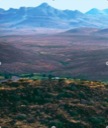RESEARCH
 LESSONS FROM THE NEIGHBORHOOD:
LESSONS FROM THE NEIGHBORHOOD:
SAN ANTONIO’S BILINGUAL CLASSROOMS
Sombrilla Magazine, UTSA 2006
Consider the corn tortilla. Curled up around itself or cradling a delicious filling, it is a staple of authentic Mexican cuisine. At Mi Rancho Restaurant on San Antonio’s West Side, cooks prepare and serve hundreds of these humble delicacies every day. Now, reconsider the corn tortilla as the main ingredient in a lesson plan for second-graders with limited English proficiency. .. PDF available
INTERDISCIPLINARY BY NATURE
Sombrilla, Spring 2009
 It’s 4 p.m. on a Monday and the normally energetic Heather Shipley is feeling the effects of her caffeine-free lifestyle. As she prepares for class, Shipley remarks that she is 10 hours into her day as an assistant professor in the Department of Civil and Environmental Engineering. As one after another of her students arrives, the roomy conference table slowly fills up with notebooks, papers, computers, and, yes, many versions of liquid caffeine. Shipley will have to draw her late-afternoon boost from water” the topic of the day, not the drink. Along with air and soil, water is a key focus of the graduate class, Analysis of Environmental Problems (CE 6273). Water, and more specifically water treatment, is also Shipley’s area of expertise. Read the full story here.
It’s 4 p.m. on a Monday and the normally energetic Heather Shipley is feeling the effects of her caffeine-free lifestyle. As she prepares for class, Shipley remarks that she is 10 hours into her day as an assistant professor in the Department of Civil and Environmental Engineering. As one after another of her students arrives, the roomy conference table slowly fills up with notebooks, papers, computers, and, yes, many versions of liquid caffeine. Shipley will have to draw her late-afternoon boost from water” the topic of the day, not the drink. Along with air and soil, water is a key focus of the graduate class, Analysis of Environmental Problems (CE 6273). Water, and more specifically water treatment, is also Shipley’s area of expertise. Read the full story here.
CERRO JUANAQUEÑA
Sombrilla Magazine, UTSA, Fall 2002
 From the top of an ancient volcanic hill, UTSA archaeologist Robert Hard can see for miles. What he sees is a series of hills stretching south to the horizon like knots on an invisible thread. Hard imagines that a very long time ago a farmer stood on the same hilltop, taking in the same landscape, wary and watchful. From four seasons of fieldwork, Hard knows that the farmer’s home would have been close by, a stick hut perched precariously on a rubble terrace. The hand-built terrace was one of many that ringed the hill, giving shelter to a small community. The farmer’s diet was spare — maize, cultivated in the river valley below, wild plants and small game like jackrabbits. The people drew water from a nearby spring, filling gourds for the steep climb. Though they possessed little, the village’s inhabitants were in constant danger of attack; eventually, though no one knows why, the settlement was abandoned. These are the facts, as gleaned from the archaeological record, about a 3,000-year-old hilltop village now known as Cerro Juanaqueña. And just about everything about these facts is surprising. … (PDF of article available)
From the top of an ancient volcanic hill, UTSA archaeologist Robert Hard can see for miles. What he sees is a series of hills stretching south to the horizon like knots on an invisible thread. Hard imagines that a very long time ago a farmer stood on the same hilltop, taking in the same landscape, wary and watchful. From four seasons of fieldwork, Hard knows that the farmer’s home would have been close by, a stick hut perched precariously on a rubble terrace. The hand-built terrace was one of many that ringed the hill, giving shelter to a small community. The farmer’s diet was spare — maize, cultivated in the river valley below, wild plants and small game like jackrabbits. The people drew water from a nearby spring, filling gourds for the steep climb. Though they possessed little, the village’s inhabitants were in constant danger of attack; eventually, though no one knows why, the settlement was abandoned. These are the facts, as gleaned from the archaeological record, about a 3,000-year-old hilltop village now known as Cerro Juanaqueña. And just about everything about these facts is surprising. … (PDF of article available)
 RESEARCH ABSTRACTS
RESEARCH ABSTRACTS
Read more of my research abstracts for Discovery Magazine here.